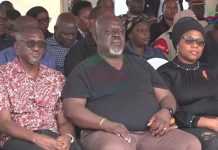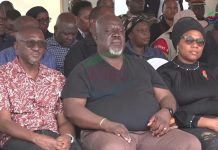Africa-Press – Zambia. Lusaka, Zambia – April 29, 2025 — The United Party for National Development (UPND) government has reiterated its unwavering commitment to energy diversification and sustainability, as the nation continues to face critical power supply challenges.
Speaking during a media briefing at Anderson Kambela Mazoka Party Secretariat, UPND Chairman for Energy and ZESCO Board Chairperson, Eng. Charles Kaisala, said that the current sector efforts align with the party’s manifesto to provide a stable and eco-friendly energy system.
ZESCO has also launched a hybrid three-tier generation model to inject 270 megawatts into the grid through a mix of utility-funded and micro-generation projects, with ongoing diversification at Kariba and Kafue Gorge including coal power initiatives.
Eng. Kaisala says infrastructure upgrades are also a priority, with key interconnectors being revamped to enhance Zambia’s regional energy trade potential. These include the Tanzania-Zambia interconnector with World Bank support, as well as enhanced connectivity to Angola, the DRC, Zimbabwe, and Malawi—positioning Zambia as a regional energy hub.
He said despite these developments, ZESCO continues to face financial headwinds, including over $800 million in legacy debt, largely owed by state-owned enterprises such as Konkola Copper Mines (KCM).
Eng. Kaisala, however, said to address this, the government is considering debt-to-equity swaps and restructuring agreements with Independent Power Producers (IPPs).
He further stressed the need for cost-reflective tariffs to ensure sector sustainability and attract further private investment. However, he assured the public that tariff reforms would be implemented with sensitivity to protect vulnerable households and ensure equitable access to power.
Eng. Kaisala said the UPND government remains resolute in its ambition to create an energy-secure, self-reliant Zambia through renewable expansion, infrastructure modernization, financial reform, and enhanced regional integration, the administration aims to eliminate load shedding and transform Zambia into a reliable net energy exporter within the region.
He noted that the electricity sub-sector remains a key pillar of Zambia’s development, but acknowledged that the country has been grappling with reduced power generation due to prolonged drought conditions.
“With approximately 84% of electricity sourced from hydropower, the country remains vulnerable to rainfall variability affecting water reservoirs such as the Kariba Dam and Kafue Gorge,” Eng. Kaisala said.
He said to mitigate the electricity deficit, which has seen the country producing 330 megawatts against a national demand of 1,330 megawatts, the government had been spending about $60 million monthly on imports.
However, Eng. Kaisala said this cost has been cut to around $20 million due to better planning and alternative sourcing, primarily from Mozambique, saving Zambia nearly $45 million each month.
He said the government has adopted a prudent water usage strategy alongside accelerated investment in renewable energy due to limited water reserves that could only sustain maximum production for two months.
Eng. Kaisala further highlighted current initiatives that have brought an additional 105 megawatts from projects in Ndola and other regions, while rooftop solar systems and hospital solarization programs are being rolled out under the Presidential Solar Initiative.
Luapula Province has been earmarked as a strategic region for energy expansion, with plans to develop green cities backed by a $45 million clean energy investment.
For More News And Analysis About Zambia Follow Africa-Press







